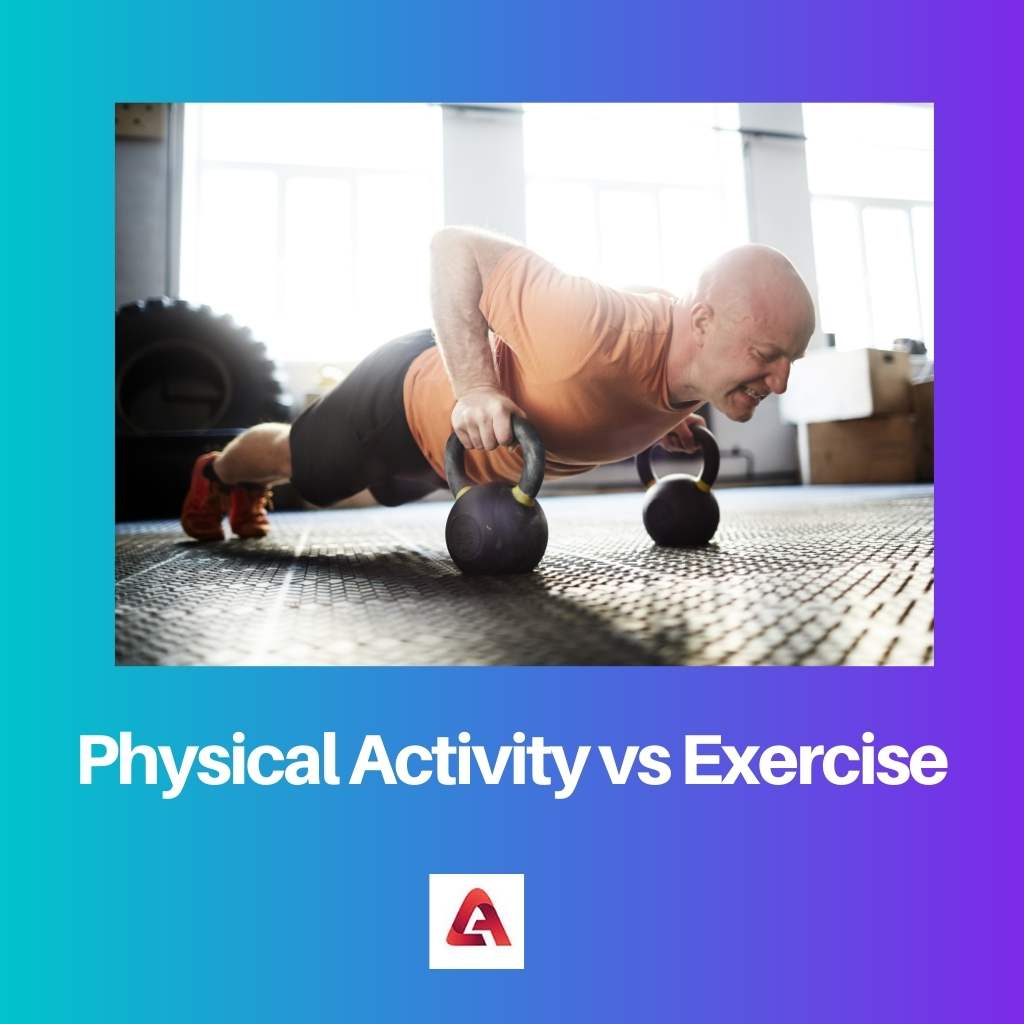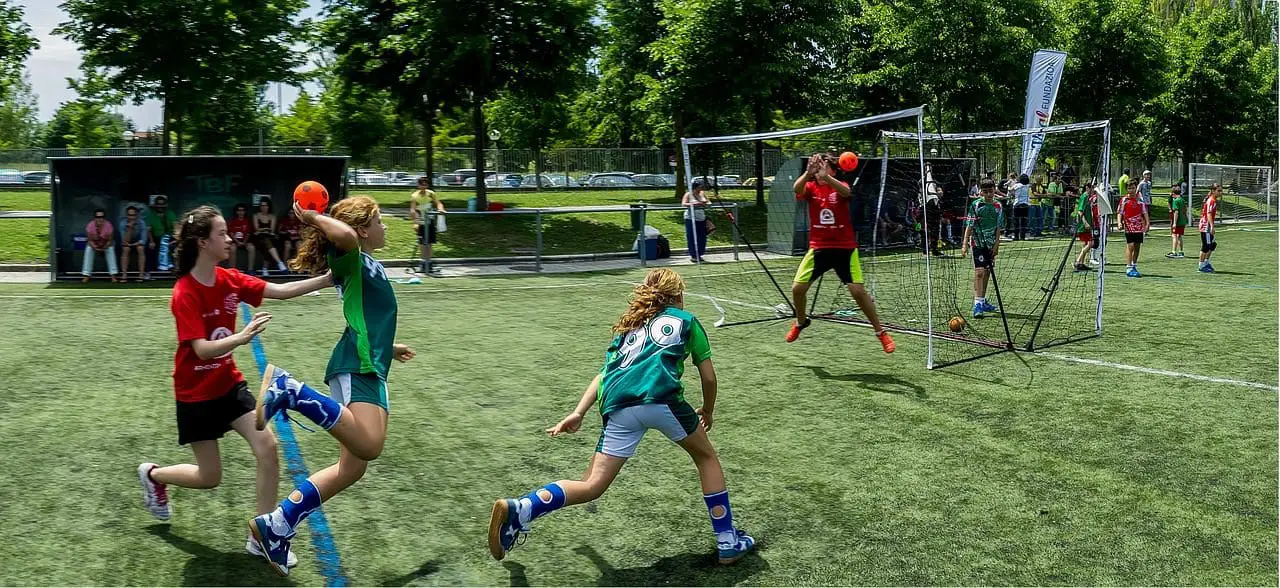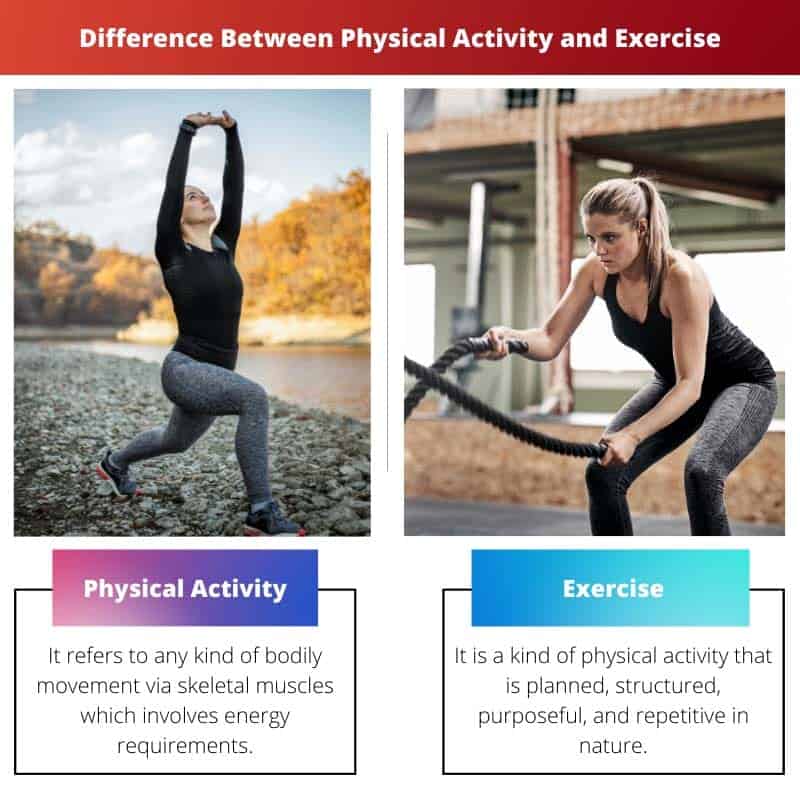Everyone wants to be happy, healthy, and free from any disease. But there are only some people who involve in physical activities to keep themselves healthy and active.
People get confused with physical activities with exercise. But it is not true. Physical activity is the movement of muscles that requires energy and doesn’t need to be planned like exercise.
Key Takeaways
- Physical activity is any bodily movement resulting in energy expenditure, whereas exercise is planned, structured, and repetitive to improve or maintain physical fitness.
- Physical activity can be leisurely or occupational, while exercise is done intentionally to achieve a specific goal.
- Exercise can be categorized into different types, such as aerobic, anaerobic, and flexibility, whereas physical activity has no such categorization.
Physical Activity vs Exercise
Physical activity is any form of body movement that causes your bones and muscles to be stressed whenever you use any amount of your energy. Exercise is a structured, purposeful, and planned physical activity that an individual does to keep their body in shape and improve their health.

Physical activity is not planned and structured like exercise. It involves any movements done by the body.
IT affects our overall health and helps us to keep ourselves fit and healthy. It varies from low to moderate intensity.
For example, any work that includes household work, cleaning, walking, gardening, etc., is considered to be Physical activity.
Any planned, structured, repetitive, and focused action of physical activity is considered Excercise. People go to the gym for having such focused and varied intensity of physical activity.
It involves making certain fitness goals and achieving that. It also involves some diets to improve the performances and outcomes of physical movements.
It helps in improving the overall fitness of the body.
Comparison Table
| Parameters of Comparison | Physical Activity | Exercise |
|---|---|---|
| Definition | It refers to any kind of bodily movement via skeletal muscles which involves energy requirements. | It is a kind of physical activity that is planned, structured, purposeful, and repetitive in nature. |
| Intensity | It varies from low to high and vigorous intensity. | It has a moderate intensity which can be vigorous over time. |
| Results | It will have health outcomes and the person doing physical activity will be in good health. | It is done to achieve fitness outcomes which include cardiorespiratory endurance, flexibility, muscular strength, body composition, and muscular endurance |
| Duration | It can be done the whole day, whenever the person is moving or walking, which counts as physical activity. | It is planned and done either in the morning or in the evening. |
| Diet | It doesn’t need any certain specific diet to be healthy. | It is purposeful in nature and thus needs a diet to achieve the goals and the desire outcomes. |
What is Physical Activity?
A general normal body movement is done throughout the day, such as doing house chores, gardening, playing, or standing or walking, these all are considered to be Physical activity.
Not all people have time to go for a planned workout in a gym or park, but still, fitness can be achieved by increasing the intensity of physical activities.
It doesn’t focus on a specific area or help in building muscles, but it can be done to be active, to have good aerobic and muscular strength, and cardiovascular strength, and to avoid a sedentary lifestyle which invites a lot of diseases in the body.
It includes the movement of skeletal muscles, which requires energy to move, and it improves the overall well-being of a person.

What is Exercise?
Exercise can be said as a moderate intensity of physical activity which is done to achieve a fitness level. It helps in increasing cardiovascular health, flexibility, building muscles, building muscular endurance, etc.
It is a planned, structured, and repetitive physical activity which requires a focused action to have the desired goals.
Exercise needs dedicated time and effort, and also sometimes a specific diet to improve fitness. They have varied intensity and are done to improve body composition.
Using treadmills and dumbbells, swimming, stretching, and lifting weights are considered to exercise. some advantages of exercise include boosting energy, weight loss, improving mood
and promoting better sleep, and reducing the risk of several types of diseases. Any sports, such as Tennis, golf, football, etc, are also considered as exercise.

Main Differences Between Physical Activity and Exercise
- Any kind of body movement which helps in losing some calories is called physical activity, whereas Excercise is a planned and structured physical activity.
- The intensity of any physical activity varies from high to low intensity, whereas Exercise has moderate to high intensity, and there is also additional equipment used to do certain exercises.
- Physical activity is beneficial in keeping a person healthy and active for everyday life, whereas Exercise is done to reach some fitness goals, to improve certain areas like flexibility, muscular strength, endurance, etc.
- Any physical movement in the whole day is counted as physical activity, and there is no certain time for it, whereas Exercise is purposeful and planned, so it is done at a specific time when it is more productive to do that in the morning or evening.
- Physical activity doesn’t need any specific diet to have some outcome whereas exercises are done to improve a particular fitness level and thus need some specific diets to have for good results.

- https://www.ncbi.nlm.nih.gov/pmc/articles/pmc1424733/
- https://www.sciencedirect.com/science/article/pii/S0005789405803715

Differentiating between physical activity and exercise is fundamental for optimizing fitness behaviors and promoting long-term health.
The clear understanding of the differences between physical activity and exercise can empower individuals to take proactive steps toward their health and fitness goals.
Enhancing awareness about the distinctions between physical activity and exercise is essential for cultivating a more health-conscious society.
Recognizing the unique qualities of physical activity and exercise is crucial for informed decision-making to support personal health and well-being.
The distinction between physical activity and exercise gets overlooked, but understanding makes a difference in achieving a healthier lifestyle.
Educating individuals about the differences between physical activity and exercise is paramount for empowering healthier lifestyle choices.
Raising awareness of the distinctions between physical activity and exercise is pivotal for fostering a more health-conscious population.
Understanding the different types of physical fitness activities is essential for people to structure their training programs effectively.
Failure to recognize the distinct nature of physical activity and exercise can lead to misguided fitness expectations.
It’s important to address the common confusion between physical activity and exercise to improve public health and fitness literacy.
Advancing public knowledge of the different nature of physical activities and exercises can contribute to improved overall health and well-being.
Educating individuals about the distinctions between physical activity and exercise is essential for fostering healthier lifestyle habits.
Differentiating between physical activity and exercise is crucial for individuals to tailor their fitness routines to achieve their specific health and wellness goals.
Clarifying the distinctions between physical activity and exercise can help individuals make informed decisions about their fitness behaviors.
Misunderstanding the differences between physical activity and exercise can lead to ineffective fitness strategies and suboptimal health outcomes.
The health benefits of physical activity and exercise need to be widely recognized and promoted to address the growing health concerns of sedentary lifestyles.
Lack of clarity on the differences between physical activity and exercise may contribute to the prevalence of inactivity-related diseases.